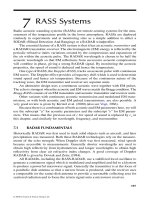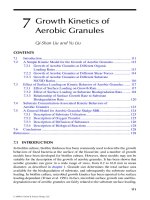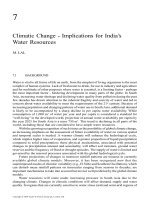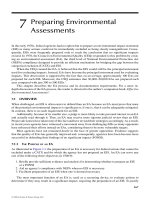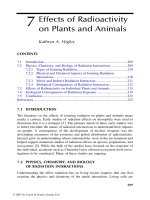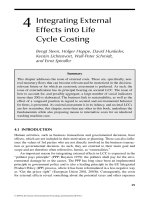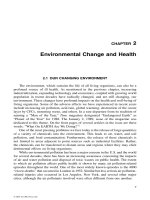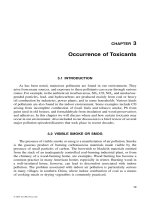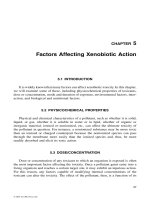Environmental Risk Assessment Reports - Chapter 7 docx
Bạn đang xem bản rút gọn của tài liệu. Xem và tải ngay bản đầy đủ của tài liệu tại đây (430.71 KB, 12 trang )
LA4111/ch07 Page 231 Wednesday, December 27, 2000 2:59 PM
PART II
Primers
© 2001 by CRC Press LLC
LA4111/ch07 Page 233 Wednesday, December 27, 2000 2:59 PM
CHAPTER
7
Legal Context of Environmental
Risk Assessment
Bruce Braaten
CONTENTS
I.
II.
III.
IV.
Introduction.................................................................................................233
A.
Regulatory Framework .................................................................233
B.
Expanse of Environmental Regulations .......................................234
C.
Risk in the Environmental Regulatory Framework .....................235
How Regulations Address Risk..................................................................236
A.
Preventive Regulations: “What is Safe?”.....................................236
B.
Reactive Regulations: “How Clean is Clean?” ............................237
Regulatory Methods for Addressing Risk..................................................238
A.
Numerical Standards.....................................................................239
B.
Technology-Based Standards........................................................240
C.
Risk Assessment ...........................................................................240
Conclusion ..................................................................................................243
I. INTRODUCTION
A. Regulatory Framework
Environmental regulations generally provide the basis for conducting a risk assessment. Risk assessment is usually a specific legal requirement within an overall
program of environmental regulation. The overall program significantly impinges
on how risk assessment is conducted, on the process and product standards governing
report acceptability, and on how risk assessment is used. Consequently, a project
manager must be aware of the most recent statutes and regulations governing the
233
© 2001 by CRC Press LLC
LA4111/ch07 Page 234 Wednesday, December 27, 2000 2:59 PM
234
A PRACTICAL GUIDE TO ENVIRONMENTAL RISK ASSESSMENT REPORTS
risk assessment project. Unfortunately for the project manager, locating the specific
legal provisions that apply to a given project can be challenging.
B. Expanse of Environmental Regulations
Since the early 1970s, environmental law has grown into a tremendous body of
statutes, rules, and court decisions. Note that this chapter presents general information on the relationship between environmental law and risk assessment. Nuances
of the law may be very important in specific instances, but are not presented here.
Although the number of federal statutes may not appear too overwhelming, these
regulations are daunting in their individual complexity and scope. A single statute
may, for example, embrace hundreds of pages of detailed regulatory requirements.
A number of players have a role in developing environmental regulations. To
become a federal statute, a bill must be passed by both houses of Congress. The
President must then sign, or not veto, the bill. Statute compilations are codified in
legal codes, such as the U.S. Code (U.S.C.).
In most instances, the statute instructs the U.S. EPA to promulgate a rule to
making procedures. These procedures require that the public receive notice of the
proposed rule and an opportunity to comment on its provisions. After considering
public comments, the U.S. EPA promulgates the rule as final. Federal rules are
published in the Code of Federal Register (C.F.R.).
Under many federal environmental statutes, states may be delegated authority
to administer the federal program. To receive this authority, the state’s applicable
statutes and rules must be at least as stringent as the federal regulations. States which
develop sufficiently stringent rules and otherwise qualify to administer and enforce
the federal program, are said to have “primacy.”
States that seek primacy over new federal environmental programs typically pass
statutes paralleling the federal statute. Based on authority found in the state statutes,
the state regulatory agency, in turn, promulgates the state rule. Thus, the overall
environmental regulatory framework consists of four players: the U.S. Congress; the
U.S. EPA; the state legislature; and the state environmental agency.
For example, the U.S. Congress enacted the Safe Drinking Water Act of 1974
(SDWA). Congress amended the SDWA in 1986.* Within the statute, Congress
instructed U.S. EPA to establish maximum contaminant levels (MCLs) for chemicals
found in public drinking water systems. The MCLs were to become the national
drinking water standards. In response, U.S. EPA developed the actual concentrations
for the MCLs.** These standards set the maximum allowable concentration for
specific chemicals. Drinking water with chemicals above these concentrations is not
considered safe. The SDWA allows the states to have primacy over their public water
supply programs provided that, in part, they adopt state standards no less stringent
than the MCLs.*** By adopting and enforcing drinking water standards of equal
or more stringency than federal MCLs, many states have received such primacy.
* 42 U.S.C. §§ 300f et seq.
** 40 C.F.R. ĐĐ 141.1 et seq.
*** 42 U.S.C. Đ 300g-2.
â 2001 by CRC Press LLC
LA4111/ch07 Page 235 Wednesday, December 27, 2000 2:59 PM
LEGAL CONTEXT OF ENVIRONMENTAL RISK ASSESSMENT
235
To appreciate the impact of the above regulatory framework, four concepts must
be understood. First, both statutes and rules have the force and effect of law. Second,
with fifty states each developing regulations, differences occur in the rules governing
identical situations in different states. Third, all four layers — both state and federal
statutes and rules — must be grasped to gain a complete understanding of a state
regulatory program. Fourth, environmental regulations are dynamic, unlike the static
laws of natural science. For environmental scientists, this can be a difficult to accept.
Whereas the physical laws are constant, there is no guarantee of constancy in
environmental law. Environmental law is a relatively new, continually evolving, body
of law. A change by Congress can cause a whiplash effect down through the federal
rule, state statute, and state rule.
In addition to statutes and rules, agency guidance and court decisions play
significant roles in the environmental arena. When a regulatory agency develops
guidance documents, the guidance generally provides supplemental detail on how
the agency will implement or apply its regulations. Sometimes the policy is formally
published as guidance documents. Sometimes it is found in agency memoranda or
letters. Agency guidance is not legally binding (i.e., guidance documents do not
pass through the rule making process). In practical terms, however, agency staff who
review project progress, certify compliance, and enforce regulations rely heavily on
applicable guidance.
Ultimately, disputes over the application of statutes or rules are resolved in court.
Court decisions address a wide array of issues, such as whether a statute authorizing
the rule is constitutional, whether a rule developed by an agency is within the
authority provided by a statute, whether the way a rule is applied to a plaintiff is
both constitutional and within the bounds of a statute and rule, and whether the
interpretation of myriad technical and legal terms that comprise a rule and statute
is proper. Court decisions can serve as guides for judges, attorneys, and savvy project
managers to project how courts will rule on future court cases interpreting similar
regulatory language or addressing similar legal issues.
C. Risk in the Environmental Regulatory Framework
A single, universal objective runs throughout the vast body of environmental regulation — to protect human health and the environment. Toward that goal, environmental regulations provide the means to protect human health and environment from
a wide range of threats from toxic substances. The toxic substance of concern is
typically identified in either the legal definitions, lists of parameters and their associated legal concentrations, or in terms of methods or physical criteria for determining whether a given substance poses the threat addressed by the regulation.
The objective of environmental regulation is rarely debated. Instead, debate
revolves around how to protect the environment and human health from a specific
situation. The debate may center on whom (human health) or what (ecology) is to
be protected (i.e., the receptors). It may deal with the means of controlling the
threats, through technological or policy-based solutions. Or, it may focus on the
appropriate level of risk to deem “acceptable” to adequately protect receptors. Risk
assessment may play a role in each type of debate.
© 2001 by CRC Press LLC
LA4111/ch07 Page 236 Wednesday, December 27, 2000 2:59 PM
236
A PRACTICAL GUIDE TO ENVIRONMENTAL RISK ASSESSMENT REPORTS
Regulatory requirements for a risk assessment are located within the thousands
of pages of environmental regulations. Regulations may require that the regulatory
agency perform the risk assessment, or may allow it to be performed by the regulated
party. Provisions for a risk assessment may be explicit. For example, the Superfund
site investigation report must include: a description of known contaminants; a
description of pathways of contaminant migration; and, an identification and description of human and environmental targets.* Or, the risk assessment requirements
may be implied from the broad regulatory language. For example, a requirement
may be stated as “the impact cannot adversely impact the human health and the
environment.”
This chapter presents an overview of how environmental regulations address
risk, primarily through the use of numerical standards, technology-based standards,
and risk assessment.
II. HOW REGULATIONS ADDRESS RISK
In general, environmental regulations can be categorized as being either preventive
or reactive. These categories are depicted in Table 1.
A. Preventive Regulations: “What is Safe?”
Preventive regulations prevent or minimize the introduction of a given environmental
contaminant into the environment. The critical issue is deciding how much of a
contaminant can be “safely” introduced into the environment. The preventive regulations can be subcategorized. The first preventive subcategory places restrictions
on the use or application of a product containing the substance that may become an
environmental contaminant. Examples of such restrictions include The Federal Insecticide, Fungicide, and Rodenticide Act’s (FIFRA) regulatory prohibition of the use
of a pesticide in a manner inconsistent with its registered label or Toxic Substances
Control Act’s (TSCA) regulation of Polychlorinated Biphenyls (PCBs) usage.** The
second preventive subcategory requires the minimization or removal of a contaminant from an emission or effluent discharge by controlling the discharge or emission
rates of the material. This minimization or removal occurs after the completion of
a process, but prior to its release into the environment. The Clean Air Act (CAA)
or The Clean Water Act (CWA) technology-based treatment requirements are examples of restrictions on emissions or effluent discharges.***
1. Role of Environmental Impact Statements within Preventive
Regulations
Within the preventive environmental regulations, the role of the National Environmental Protection Act of 1969 (NEPA) warrants discussion.**** NEPA requires that
* 40 C.F.R. § 300.420 (c).
** 7 U.S.C. § 136j, 15 U.S.C. § 6.
*** 42 U.S.C. § 7412 (d), 33 U.S.C. Đ 301.
**** 42 U.S.C. ĐĐ 4321 et seq.
â 2001 by CRC Press LLC
LA4111/ch07 Page 237 Wednesday, December 27, 2000 2:59 PM
LEGAL CONTEXT OF ENVIRONMENTAL RISK ASSESSMENT
Table 1
237
Regulatory Approaches to Risk
Environmental Regulations Universal Objective:
Protect human health and the environment
Type
Preventive Regulations
Reactive Regulations
Goal
Prevent or minimize contamination
Respond to contamination
How
Control use
Control
discharge or
emission rates
Environmental contaminations
not controlled
For example
Regulate
pesticide
application
rates (FIFRA)
Set risk levels at
concentration
levels or SDWA
MCLs
Set risk levels using risk
assessment (CERCLA,
RCRA, TSD facility, and
LUST corrective actions)
PCB regulation
and
enforcement
(TSCA)
Set risk levels at
technologybased
standards
(CWA or CAA)
the federal government take into account environmental impacts in the administration
of their functions and programs.* To that end, NEPA contains the Environmental
Impact Statement (EIS) process. ** The purpose of the EIS process is to collect,
analyze, and prepare information on the potential adverse environmental impacts of
a proposed action. Before a decision is made to allow an action, the EIS report is
to be provided to the decision makers.
Not all preventive programs require an EIS. The threshold test for determining
if an EIS is required is “whether a major federal action significantly affects the
quality of the human environment.”*** An attorney should be consulted on a proposed project in regard to the need for an EIS. For example,“federal actions” include
issuing permits.
If a federal EIS is triggered, a report is required containing: the environmental
impact of the proposed action; any adverse environmental effects which cannot be
avoided, if the proposal is implemented; alternatives to the proposed action; the
relationship between local short-term uses of the environment and the maintenance
and enhancement of long-term productivity; and any irreversible and irretrievable
commitments of resources if the proposed action is implemented.
B. Reactive Regulations: “How Clean is Clean?”
The reactive regulations reduce the concentration level after a contaminant has
already been released into the environment at unacceptable levels. At issue is the
level of contamination that can be “safely” left in place. In other words, “how clean
is clean?” The acceptable level of risk dictates how much contamination may be left
in place without posing an unacceptable threat. Examples of reactive regulation
programs include Superfund;**** and RCRA - Subtitle S treatment, storage, and
* 42 U.S.C. § 4321.
** 42 U.S.C. § 4332.
*** 42 U.S.C. Đ 4332 (c).
**** 40 C.F.R. Part 300.
â 2001 by CRC Press LLC
LA4111/ch07 Page 238 Wednesday, December 27, 2000 2:59 PM
238
A PRACTICAL GUIDE TO ENVIRONMENTAL RISK ASSESSMENT REPORTS
Table 2
Federal Cleanup Process
Superfund
RCRA
Abandoned/inactive
Disposal Sites
Permitted TSD Facilities
(Subtitle S)
Leaking Underground
Storage Tanks (Subtitle I)
Site Discovery/Notification
↓
Remedial Investigation
↓
Initial Release Response
↓
Preliminary
Assessment/Site
Investigation
↓
Corrective Measure Study
Initial Abatement Measures
& Site Check
↓
↓
HRS — II Scoring/NPL
Listing
↓
Remedy Selection
Initial Site Characterization
↓
↓
Remedial
Investigation/Feasibility
Study
↓
Remedy Design/Remedy
Implementation
Free Product Removal
Remedy Selection
↓
Remedial Design/Remedial
Action
↓
Investigation of Soil &
Groundwater
↓
Corrective Action Plan
disposal (TSD) facility corrective actions,* and RCRA - Subtitle I leaking underground storage tank (LUST) corrective actions.**
III. REGULATORY METHODS FOR ADDRESSING RISK
Three regulatory methods address the setting of an acceptable level of risk to a
contaminant exposure. These methods are: numerical concentration standards, technology-based standards, and risk assessment (see Table 1).
Numerical concentration standards and technology-based standards are generally
employed in preventive programs. One subset of the preventive regulations are those
that control the discharge or emission rate; these regulations usually entail the
issuance of a permit. The permit specifies the standards for emission or effluent
discharge of a contaminant. Depending on the regulatory program, standards can be
either numerical concentrations or technology-based. Risk assessment enters the
permitting process when the agency determines how stringently to set these standards. Agencies, not the project manager, typically conduct risk assessments in these
programs. There are exceptions to the general pattern of agencies conducting risk
assessments under preventive regulatory programs. For example, private parties
seeking some combuster permits may need to conduct a risk assessment.
The second subset of the preventive regulations are those that control the use of
the chemical material. These regulations may require registration or premanufacture
* 12 40 C.F.R. Part 264 (proposed July 27, 1990). At the time of editing this chapter, advance notice of
proposed rulemaking was issued by U.S. EPA pertaining to this proposed rule.
** 40 C.F.R. Part 280.
© 2001 by CRC Press LLC
LA4111/ch07 Page 239 Wednesday, December 27, 2000 2:59 PM
LEGAL CONTEXT OF ENVIRONMENTAL RISK ASSESSMENT
239
notice to the U.S. EPA. In these programs, the private parties conduct the risk
assessment, not the agencies. For example, manufacturers are required to perform
risk assessments to register a new pesticide under FIFRA, or to produce a new
chemical under TSCA.
A. Numerical Standards
The first approach to risk is the use of numerical concentrations as standards.
Generally, these numerical standards are human-health based. Risk assessment is
used to determine the maximum concentration levels that will not cause any adverse
health effects in humans exposed for a given exposure period. These numerical
concentrations provide the minimum acceptable level of human health protection.
There may also be numerical standards set for ecological-based protection.
To establish a health-based standard, an agency, first, collects and evaluates data
to identify the COCs. Second, an exposure assessment is made to determine the
level of exposure necessary to cause adverse health impacts and to evaluate the
potential exposure to the contaminants. Third, the agency conducts a toxicity assessment by gathering evidence from a variety of sources “regarding the potential for a
substance to cause adverse effects (carcinogenic and noncarcinogenic) in humans.
These sources may include controlled epidemiologic investigations, clinical studies,
and experimental animal studies.”* Within these three steps, the potential risk for
adverse effects to occur is characterized. Finally, toxicity values for carcinogenic
and noncarcinogenic effects are developed. As part of the development for carcinogenic values, a calculation is made using a lifetime risk level assumption.** This
assumption is based on a policy decision such as 1 in 100,000 or 1 in 1,000,000
risk level.
The SDWA is an example of a preventive program that uses numerical standards.
The SDWA authorized U.S. EPA to promulgate health-based drinking water standards.*** In promulgating these standards, U.S. EPA performs a risk assessment to
determine the level of contamination that will not adversely impact human health.
U.S. EPA then issues numerical health-based standards, as Maximum Contaminant
Level Goals (MCLGs) and MCLs. MCLGs are the concentrations at which no
known, or anticipated, adverse effects occur to human health, and which allow an
adequate margin of safety. MCLGs are not enforceable. MCLs are set as close to
MCLGs as feasible. Feasibility reflects the best available technology, including cost
and treatment technology.**** MCLs are the federally enforceable public drinking
water regulations.
* 14 Risk Assessment Guidance for Superfund, Vol. I, Human Health Evaluation Manual (Part A), EPA,
7-3, 1989.
** 15 Risk Assessment Guidance for Superfund, Vol. I, Human Health Evaluation Manual (Part A), EPA,
1-7, 1989.
*** 42 U.S.C. § 300f.
**** 42 U.S.C. § 300g-1.
© 2001 by CRC Press LLC
LA4111/ch07 Page 240 Wednesday, December 27, 2000 2:59 PM
240
A PRACTICAL GUIDE TO ENVIRONMENTAL RISK ASSESSMENT REPORTS
B. Technology-Based Standards
The second regulatory approach to risk is the use of technology-based standards.
Technology-based standards consider the effectiveness of pollution control technology
applied at the “end of the pipe” to minimize or eliminate air emissions or effluent
discharge. The agency setting the standards selects the most effective treatment technology available (the “best”) that can reasonably remove contaminants out of the
process stream. The standard for removing particulate matter from air emissions, for
example, would require the use of the most effective scrubber or filter treatment
technology. In selecting a particular technology, the agency determines that it represents the best that can be achieved to eliminate or minimize the release of an environmental contaminant. Under technology-based standards, as long as the required
technology is used, remaining emissions or discharges are deemed acceptable.
For example, Title III of the Clean Air Act Amendments of 1990 requires the
use of maximum achievable control technology (MACT) as a technology-based
standard for the emission of hazardous air pollutants. “The maximum degree of
reduction in emissions that is deemed achievable for new sources . . . shall not be
less stringent than the emission control that is achieved by the best controlled similar
source.”* Thus, the standard for a new source is the pollution reduction that technology can achieve, using the best control technology. The standard considers the
best performing control technology of similar sources. Factors such as cost and
energy requirements may be included in the technology selection. In addition, there
is a unique CAA provision for setting health-based threshold levels for hazardous
air pollutants.** U.S. EPA is to report to Congress within eight years of promulgating
a MACT standard, and make recommendations about the health risk remaining after
application of the technology-based emission standards.***
Other examples of technology-based standards include the Clean Water Act
requirements for existing point sources. These effluent limitation requirements
include the use of an industry specific, best practicable control technology.****
RCRA also has requirements for the use of best demonstrated available technologies,
as a treatment standard, before restricted hazardous waste can be land disposed.†
C. Risk Assessment
The third approach to risk is through the use of risk assessment, as part of regulating
a particular site, process, or facility. Typically, this is the type of risk assessment
you will encounter as a project manager. The technical and procedural nuances of
risk assessment are discussed in detail throughout this book.
Risk assessment can be used in this third regulatory approach to react to existing
contamination. It can be used to calculate cleanup concentrations at Superfund sites,
RCRA TSD facility corrective actions, and LUST corrective actions.
* 42 U.S.C. § 7412 (d).
** 42 U.S.C. § 7412 (d)(4).
*** 42 U.S.C. § 7412 (f).
**** 33 U.S.C. § 301 (b).
† 42 U.S.C § 3004 (m).
© 2001 by CRC Press LLC
LA4111/ch07 Page 241 Wednesday, December 27, 2000 2:59 PM
LEGAL CONTEXT OF ENVIRONMENTAL RISK ASSESSMENT
Table 3
241
Comparison of RCRA Subtitle S-TSD Facility Corrective Action
(proposed) to Superfund Cleanup
RCRA
SUPERFUND
Corrective action on
an abandoned facility
Corrective action on a permitted facility
Facility Assessment
Facility assessment
Preliminary
Assessment (PA)
Site Inspection (SI)
Prior to permit issuance
After environmental release
Actual or suspected
release
assessment
resulting in either
PA eliminates from
futher
consideration, sites
that pose no threat
If no evidence of
release, no further
action
SI eliminates, from
futher
consideration, sites
that pose no
significant threat
(no levels
provided)
If evidence of
release, remedial
investigation with
specified (Subpart
S) permit (action)
levels not to be
exceeded
Investigation
Facility Investigation
Action levels
exceeded
Remedial Investigation
No, no further action
Yes, Corrective
Measure Study
Conducted on sites receiving HRS-II score
greater than 28.5
Remedy Selection
Conditional remedy
phase-in, with
conditions up to
length of permit
Achieve specified (in
Subpart S) media
cleanup standards
Achieve ARARs
ARAR waiver
These three remediation programs follow the same general approach to site
cleanup (see Tables 2 and 3). First, the site is initially assessed. If sufficient contamination is found, a remedial investigation is required. During the remedial investigation, the nature and extent of the risk from the contamination is characterized.
Third, during the feasibility study, plausible cleanup technologies are identified and
evaluated. Fourth, a remedy is selected to achieve the cleanup goals. Evaluation
criteria are provided. The final cleanup goals are selected. Depending on the specific
cleanup program and the complexity of the site, the detail required within the first
four steps may vary accordingly. Finally, the remedy is implemented.
Risk assessment is conducted during the remedial investigation. For Superfund,
a baseline risk assessment is required during the remedial investigation. The Superfund remedial investigation (RI) collects “data necessary to adequately characterize
the site for the purpose of developing and evaluating effective remedial alternatives.*
* 40 C.F.R. Đ300.430(d).
â 2001 by CRC Press LLC
LA4111/ch07 Page 242 Wednesday, December 27, 2000 2:59 PM
242
A PRACTICAL GUIDE TO ENVIRONMENTAL RISK ASSESSMENT REPORTS
Site characterization includes conducting field investigations and conducting a sitespecific baseline risk assessment. The field investigations are to characterize the nature
and extent of the contamination as well as a site’s physical features.
The baseline risk assessment characterizes “the current and potential threats to
human health and the environment that may be posed by contaminants migrating to
groundwater or surface water, releasing to air, leaching through soil, remaining in
the soil, and bioaccumulating in the food chain.”* The purpose of the baseline risk
assessment is to: “provide risk managers with an understanding of the actual and
potential risks to human health and the environment posed by the site and any
uncertainties associated with the assessment. This information may be useful in
determining whether a current or potential threat to human health or the environment
exists that warrants remedial action … As a general policy … EPA generally uses
the results of the baseline risk assessment to establish the basis for taking a remedial
action.”**
For RCRA TSD facility corrective actions, risk assessment may be required
during the remedial investigation. The RCRA TSD facility RI identifies the nature
and extent of the releases. The investigation may also include:
•
•
•
•
A hydrogeologic investigation
A characterization of solid waste management units (SWMUs) of concern
Descriptions of human and environmental receptors
Information in assessing risks to human health and the environment from the
releases***
The proposed subpart S rule preamble states the following in relation to the third
and fourth items above. “Section 254.511(a)(4) would provide the Agency with the
authority to require information that will assist the Regional Administrator in the
assessment of risks to human health and the environment from releases from solid
waste management units. Information collected under §264.511(a)(3) also would
integrate information on exposed humans and environmental systems and information on contaminant concentrations to assess the magnitude of threats to exposed
populations. The interim measures are appropriate prior to selecting the final remedy
or to evaluate whether a determination is warranted so that no further action is
necessary (under proposed §264.514). The permittee should refer to chapter VIII of
the RFI Guidance for information regarding the Agency’s expectations for data that
may be needed to conduct a risk assessment.”**** Moreover, the U.S. EPA has
provided the following with regard to the use of risk assessment in RCRA corrective
actions: “While some implementing agencies may require the Permittee/Respondent
to conduct a risk assessment, the policy on conducting risk assessments in the
* 40 C.F.R. §300.430(d)(4).
** Letter from Don Clay, Assistant EPA Administrator, to EPA Division Directors (April 22, 1991)
discussing the role of baseline risk assessment.
*** 40 C.F.R. §264.511 (a)(proposed).
**** 55 Fed. Reg. at 30811, July 27, 1990.
© 2001 by CRC Press LLC
LA4111/ch07 Page 243 Wednesday, December 27, 2000 2:59 PM
LEGAL CONTEXT OF ENVIRONMENTAL RISK ASSESSMENT
243
corrective action program is evolving. Currently, their use is optional at the discretion
of the implementing agency and should be based on site-specific conditions.”*
IV. CONCLUSION
Legal considerations drive risk assessment. It may be the requirements of CERCLA
or RCRA. It may be the hope of limiting future liability or liability to third parties.
Legal considerations may require action or restrict action. Either way the influence
of environmental law on the risk assessment process adds an interesting dimension
to human health and environmental risk assessments.
* RCRA Corrective Action Plan, ERA 520-R-94-004, page 52 (1994).
© 2001 by CRC Press LLC
